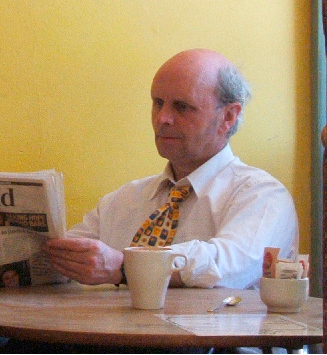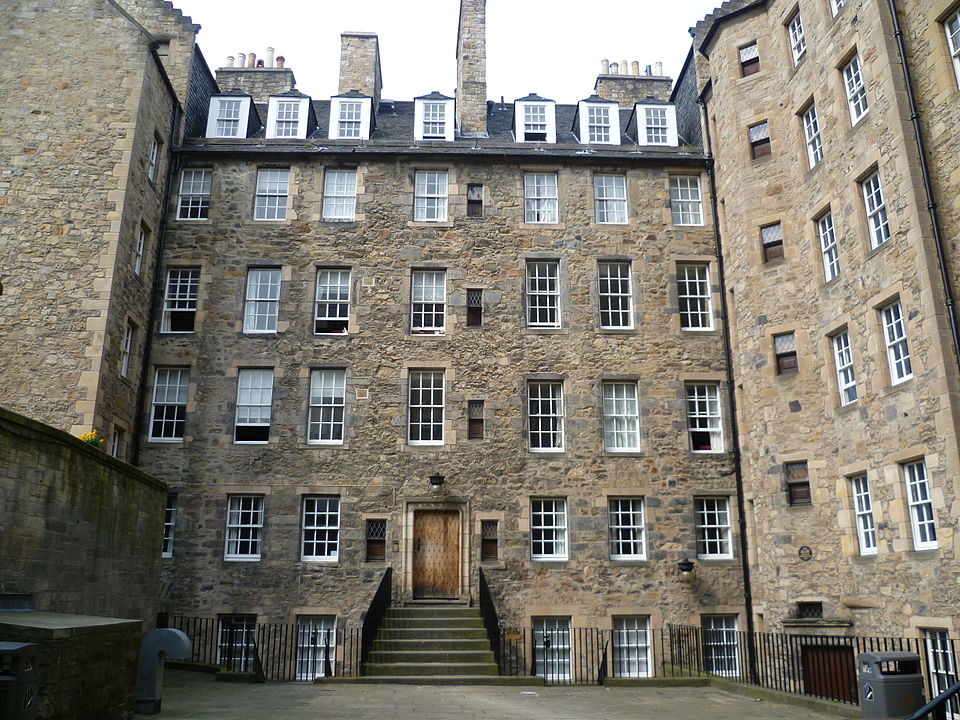David J Black: I; defenestrating Geddes; proditio in urbe

David J Black
But a city is more than a place in space. It is a drama in time. Edinburgh is - the most condensed example, the visible microcosm of the social evolution which is manifest everywhere in the city. – Patrick Geddes. Keynote lecture, London University, July 1904
Few innovative thinkers have been as misconstrued as Patrick Geddes (1864-1932) zoologist, social theorist, botanist, friend of Charles Darwin and Hugh MacDiarmid, and ‘father of town planning’. His philosophy was radical and progressive, yet rooted in a European enlightenment which sought rational alternatives to social conflict, deprivation, and intolerance. His pupil Lewis Mumford described him as one “whose life shows a constant interpenetration of the general and the particular, the philosophical outlook and the scientific outlook, the universal and the regional; this world-enveloping mind was also deeply concerned with the improvement of life at his own doorstep”.
Yet in The Death and Life of Great American Cities, Jane Jacobs ranked Geddes with Ebenezer Howard and his anti-urban Garden City Movement, rather missing the point that not only was Geddes an urbanist with communitarian values – she herself was almost the quintessential ‘Geddesian’, observing Manhattan’s West Village much as he had observed Edinburgh’s Old Town fifty years earlier.
In The City in Mind the urban theorist James Howard Kunstler, who damns American suburbia as “a tragic landscape of cartoon architecture, junked cities, and ravaged countryside”, questions the “loud and ironic chord” in Geddes’ work as he “still looked to scientific advance and technical solutions to mitigate the mess that had been made of the human habitat by previous technical advance”. Yet Kunstler gets the date of Geddes’ death wrong by three critical years in which he was knighted and published (with J.A Thomson) Life: Outlines of General Biology, indicating some lack of awareness of his work.
Certainly, Geddes shared a Victorian predilection for classification and taxonomy with Darwin, Huxley, and Clerk-Maxwell, and his writing style was often baroque. His wife Anna could despair of his “thinking machines for breakfast, dinner, and supper”; yet a concern for humanity was uppermost; he could be didactic as well as intuitive and mystical, but always followed his chosen motto, Vivendo Discimus – I learn from living. He rarely pontificated from an ivory tower. For many years he and Anna lived in James Court, then a dilapidated slum in Edinburgh’s Old Town, which became the prism through which they might view both the possibilities and the threats of urban planning worldwide.
Geddes would later put his citizen-centred ideas into effect in cities as disparate as Tel-Aviv, Bombay, and Montpelier. It goes without saying that if the poor man were to see the damage being inflicted on his beloved Edinburgh today he would be horrified, though his name is often used as a purifying fragrance to cover the misdeeds of those debasing his message. He is quoted for example in Edinburgh Council’s ‘Sustainable Development 2020 ‘action plan’: “Town planning is not mere place planning, nor even work planning. If it is to be successful it must be folk planning.”
A neat cut and paste, reinforced with added jargon. “We are committed to a strategic role for planning and design of all development and buildings in achieving sustainability by addressing social, economic, health and urban cultural heritage issues for the benefit of all.” That was in 2014, the year that Councillor Andrew Burns was making deals for publicly owned city land at London’s MIPIM property fair, Standard Life Investments were planning the regulation-breaching demolition of listed buildings in St Andrew Square, and the community of Central Edinburgh was being displaced to make way for the short-term letting industry. There was certainly nothing particularly Geddesian about the development-driven policies of Edinburgh at that point.
Geddes’ contemporaries were more appreciative of his world view. The planner Lewis Mumford heard him lecture in New York’s New School for Social Research in 1923 and was so overawed that he named a son after him. Where Kunstler disapproves of Geddes’ (alleged) scientific methodology, Mumford focused on his “organic humanism” which regarded technology and science as subservient to community, challenging such techno-determinists as Marshall McLuhan, who posited that technology, rather than the natural environment, would shape mankind’s destiny – yet eventually Mumford himself would catch the comprehensive redevelopment bug and abandon his own Geddesian instincts.
An instance of degeneration posing as Geddesian regeneration with which I had an association was Riddle’s Court, a 16th century merchant’s house, and one of the most important surviving courtyard complexes in Edinburgh Old Town. Rescued from dilapidation by Patrick Geddes in the 1890s, it was ‘restored’ – I use the word advisedly – by the Scottish Historic Buildings Trust in 2016. I was a trustee of this organisation for more than ten years, but with the desecration of Riddle’s Court, which I’d known since childhood, I felt obliged to resign. The architect appointed to carry out the scheme (presented as a fait accompli to the trustees) was LDN, creator of the Usher Hall’s ‘glass banana’, and ‘court architect’ to Edinburgh University, though a practice far removed in spirit from the one established by my fellow old Town Association founder, Sir James Dunbar-Naismith.
The Trust’s strapline – Historic Architecture meets Contemporary Design – hints at the fate which befell this so-called ‘Patrick Geddes Learning Centre’. It was meant to be a best-practice exercise in conservation, yet that noble objective was distorted by a typical ‘bold intervention’, ruthlessly executed when a first floor room was obliterated, its cantilevered access stone staircase sawn off with a disc saw.

Milne's Court (1690), Edinburgh. Under the influence of Patrick Geddes, these buildings were renovated in 1914, becoming a university hall of residence. Credit: Kim Traynor, CC BY-SA 3.0
More ‘boldness’ followed. Instead of the conservative surgery which Geddes had once promoted, a mass of steel and glass destroyed any charm which Riddles Court had possessed. It would have been difficult to come up with a more anti-Geddessian treatment for any building, far less this one.
It wasn’t that the architects didn’t understand conservation. They were just determined to pursue an anti-heritage agenda. When I suggested the staircase should have a timber balustrade rather than a glass and steel one and lost by one vote I decided it was time to leave. It wasn’t that I was being a heritage fogey by any means (indeed I’d floated the idea that artist John Byrne be invited to design the balusters) but simply that the contemplated heritage vandalism was as unnecessary as it was inappropriate.
Consider what was being damaged. Riddle’s Court was of major historical importance. As a festival venue it had provided a stage for, among others, Dame Maggie Smith, Stephen Fry, Hugh Laurie, and Emma Thompson. In 1598 King James VI had hosted a banquet there for his consort, Anne of Denmark, and her brother the Duke of Holstein. The Trust later listed the restored banqueting rooms with Airbnb as ‘The King’s Chamber’, making them largely inaccessible to the public. The philosopher David Hume – a man with strong views on taste and beauty in architecture, who lived there in the 1750s, would undoubtedly have described this particular restoration as a ‘deformity’.
Geddes’ association with Mumford, who was initially influenced by him, but was not in the final analysis a true follower to some degree eclipsed the older man’s communitarian urbanism. While conceding that “my chief intellectual debt is to my master, Patrick Geddes” Mumford wrote “I could never be the kind of faithful doglike disciple that he would have liked in order to carry out his own unfulfilled ideas and schemes”. Mumford later wrote the introduction to Rebuilding Cities, the urban clearfell tract of Percy Johnson Marshall, perpetrator of the chilling 1963 Comprehensive Development Area plan to destroy and rebuild Edinburgh’s Southside. Mumford, indeed, would ultimately betray his mentor by embracing the very planning doctrines Geddes disapproved of. Nonetheless, the beliefs of both men are often conflated. David Watkin, wrote in 1980:
Mumford – was originally inspired by the Scottish theorist of urban planning, Patrick Geddes, but has developed a highly personal and romantic kind of ‘biological’ Marxism which he applies to the problems of urban architecture as part of his grandoise vision for forming a new world order through intensive community planning – a process which must end by involving the same kind of barbarisms as the technologically dominated and totalitarian states he condemns. [The Rise of Architectural History]
Mumford’s reasoning was not always consistent. His long 1962 essay, The Case Against Modern Architecture, while it certainly bemoaned the “superficial esthetic” of modernism, also criticised the traditionalism of American architect critic Henry Hope Reed as “too empty and vulnerable to merit more than a passing smile”. That same year he wrote a scathing review of Jane Jacob’s Death and Life of Great American Cities for The New Yorker, irked, we may suspect, that it might be a Christmas rival to his own recently published The City in History. In his introduction to Percy Johnson Marshall’s above mentioned book Mumford heaped praised on the author’s “sense of responsibility to his public mission [which] goes beyond even the high tradition of the British Civil Service” – the elimination of Edinburgh’s mid 18th century Southside and its resident community being part of that same mission.
Was Watkin implying that Geddes too preached a proto-Marxist programme of social control? Geddes biographer Helen Meller, by contrast, described his approach as essentially non-ideological: “Geddes was able to view the political debate about the future as largely irrelevant. He chose to consider that his position was above the fierce discussions about capitalism and its social consequences.” Andres Duany (to whom Kunstler dedicates The City in Mind) also gives Geddes leeway, acknowledging him in his own philosophy of ‘transect planning’ and crediting him with “the first transect that included human activity in correspondence with the declension of natural functions. Humans were considered part of the habitat.” For Duany, Geddes is less scientific than fellow Scot, Ian McHarg, founder of Penn University’s School of Landscape Architecture, whose 1969 Design With Nature promoted an ecological approach to planning. Like Geddes and McHarg, Duany has the healthy instincts of a battling polemicist – he once told a group of us on a tour in Charleston, South Carolina that his job as an urbanist advising government was to be “one hell of a son of a bitch”. Talk about a breath of fresh air! He was also witheringly dismissive of architecture’s poseur stylists, especially those he considers to be “extremely narrow and - of the order of freaks, acrobats, clowns and magicians: the circus of Archigram, Yona Friedman, Metabolism, Linear Cities, Event-Cites, Ecocities and so forth. All - characterized by obsessive avant-gardism”.
Despite the efforts of Duany, Calthorpe, Scully, Sennett and other urbanists in an age of city-dwellers the lessons of Geddes are not just ignored, but reversed, in both his Edinburgh ‘petri-dish’ and the wider world; yet change may be on the way. Extinction Rebellion demonstrations, once dismissed as fringe aberrations, are gaining broad support, while the 2019 RIBA Stirling Prize was won not by some flashy ego-icon but by an energy efficient council estate of terraced homes. It’s been a long time a-coming, and for many cities it is already too late. It was more than 30 years ago that the UN ‘Agenda 21’ conference in Rio ran under the slogan Think Global, Act Local.
These, as it happens, are the same four words first coined by Patrick Geddes in his 1915 book, Cities in Evolution!





